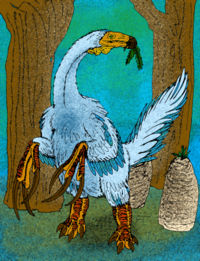Therizinosaurus
2007 Schools Wikipedia Selection. Related subjects: Dinosaurs
| iTherizinosaurus |
||||||||||||||||||||
|---|---|---|---|---|---|---|---|---|---|---|---|---|---|---|---|---|---|---|---|---|
 |
||||||||||||||||||||
|
|
||||||||||||||||||||
|
Extinct (fossil)
|
||||||||||||||||||||
| Scientific classification | ||||||||||||||||||||
|
||||||||||||||||||||
|
|
||||||||||||||||||||
| Therizinosaurus cheloniformis Maleev, 1954 |
Therizinosaurus ('scythe lizard', from the Greek therizo meaning 'to reap' or 'to cut off' and sauros meaning 'lizard') was a very large therizinosaur (previously known as segnosaur). It could grow up to 10-12 meters (33-40 feet) long and reach 3-6 tons in weight. Therizinosaurus lived in the late Cretaceous Period around 70-75 million years ago, and was one of the later and largest representatives of its unique group. Its fossils were first discovered in Mongolia and when it was discovered it was originally thought to be a turtle (hence the name cheloniformis - turtle-formed) but it is now accepted as a maniraptoran theropod dinosaur.
Discovery and Species
The first fossils now attributed to Therizinosaurus were discovered in the late 1940s by a joint Soviet-Mongolian fossil expedition. The expedition unearthed several giant claws which measured up to a meter in length - but to what creature these belonged was unknown until the early 1950s, when further fossil expeditions unearthed more bones - several more sets of claws and parts of a forelimb and hindlimb. Subsequent finds in northern China allowed paleontologists to assemble the general skeletal structure of the animal, which was determined to be a dinosaur and not a turtle. In 1954, the animal was named Therizinosaurus ('scythe lizard'), referring to the enormous claws. At present, there is one accepted species - T. cheloniformis.
The recent discovery of several related dinosaurs - Alxasaurus in 1993 and Beipiaosaurus in 1996 - helped clarify the position of the therizinosaurs as a whole. Various theories had been proposed to explain the ancestry of these dinosaurs, with some scientists even suggesting they were descendents of the sauropodomorphs - but these new, well-preserved finds, giving details about the bird-like pelvis, feet and skulls, helped confirm that the therizinosaurs were all maniraptoran, theropod dinosaurs.
Characteristics
Therizinosaurus had a small head with a beaked mouth, atop a long neck. It was bipedal and had a large, heavy, deep body, as evidenced by the wide pelvis, 2.5 meter (8 foot) long 'arms' and hind legs that ended in four toes (three of which supported the animal's weight), which were tipped by short, curved claws. The most distinctive feature of the animal was the presence of three gigantic claws on its front limbs. Each of the three digits of its 'hand' bore these claws, which reached nearly a meter (approximately 2-3 feet) in length. The largest claw was on the first digit.
The feeding habits of Therizinosaurus are still debated, but it was most probably an herbivore, using its big claws to push leaves into its mouth. Other hypotheses suggest that it was a termite eater, using its claws to open large termite nests - but it seems highly unlikely that an animal the size of Therizinosaurus could survive on a diet based on insects and features of the skull (including a beaked mouth and flattened teeth) suggest a herbivorous diet . It is thought that Therizinosaurus lived a similar lifestyle to modern gorillas or prehistoric ground sloths, using its long arms and sharp claws to grab food and foliage from trees.
There are other possible functions that could have been served by the claws of Therizinosaurus, such as defense against predators (e.g. the contemporary Tarbosaurus) and in intraspecific fighting, such as fighting for territory or for mating. The claws may even have served all these functions.
It is highly likely that Therizinosaurus was feathered, given that its close relative Beipiaosaurus certainly was.
In popular culture
Therizinosaurus appeared in the BBC Walking With Dinosaurs special "Chased By Dinosaurs".
Therizinosaurus appears in the Playstation video game Dino Crisis. In the game, Therizinosaurus is portrayed as an active predator rather than a herbivore.